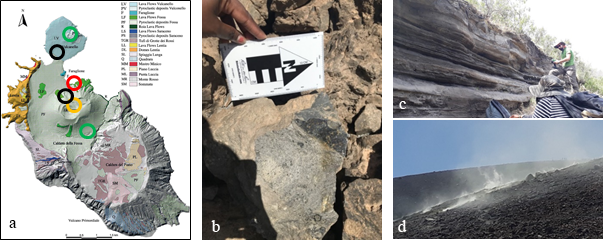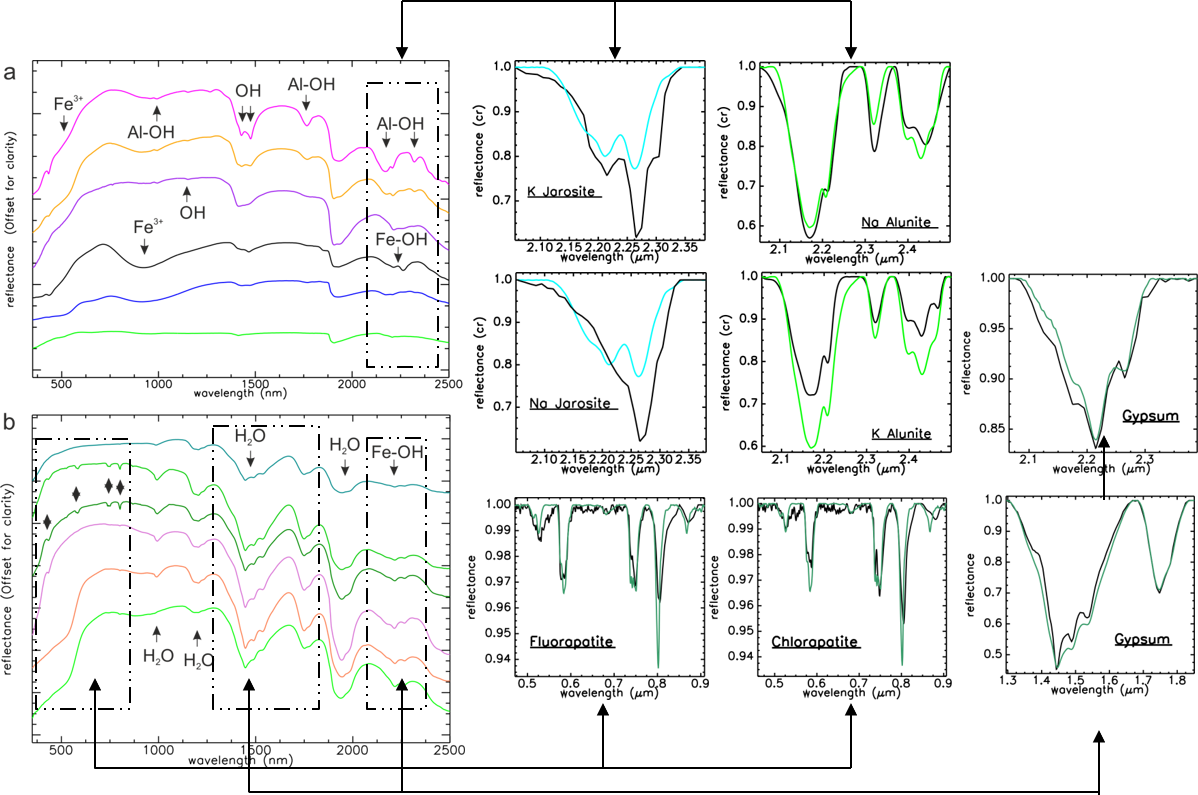- 1German Aerospace Center, DLR, Institute of Planetary Research, Berlin, Germany (katrin.stephan@dlr.de)
- 2Institute of Optical Sensor Systems, DLR, Berlin, Germany
- 3Department of Earth Sciences, Natural History Museum, London, UK
- 4Dept. of Physics and Geology, University of Perugia, Italy
- 5Department of Physics & Earth Sciences, Jacobs University Bremen, Germany
Abstract
During the fifth International Summer School held on Vulcano (Eolian Islands, Italy) in June 2019 we started the investigation of volcanic deposits with different spectral instruments combining mineralogical, elemental and molecular information [1, 2]. The island of Vulcano presents an extremely large variety of volcanic products [3] in extreme acid alteration conditions. Acidic alteration may also have been a key process throughout Martian geologic history making Vulcano a perfect analog for studies on Mars by defining the geochemistry at these sites. In this work we present an update of our spectral investigations based on the VIS-NIR spectral measurements.
Instrumentation and Methods
In the field we used a portable spectro-radiometer (PSR+3500) that works in the visible and near-infrared spectral range (350 – 2500 nm) with a spectral resolution between 3 and 8 nm, which is best used for mineralogical content of the investigated deposits.
In order to investigate the measured spectra we used a combination of open spectral libraries such as provided by the USGS [4] and the PDS GeoScience Node [5]. To compare the spectra measured in the field with entries in these spectral libraries, spectral matching algorithm implemented in the IDL/ENVI software were employed. The Spectral Angle Mapper (SAM) algorithm [6] determines the spectral similarity between two spectra by calculating the angle between the spectra and treating them as vectors in a space with dimensionality equal to the number of bands. The Spectral Feature Fitting (SFF) algorithm [7] compares the fit of measured spectra to reference spectra using a least-squares technique.
Study area
Vulcano is one of the Aeolian Islands situated in the Tyrrhenian Sea northeast of Sicily, Italy [3]. Above sea-level volcanic activity in this region began around 400 ka due to the subduction of the African plate under the Eurasian plate, triggering tectonic instability and risingmagma, resulting in volcanic activity in the region [8].
The data collected for this study mostly stem from classical lava rocks with dark and bright phenocrysts and dark glass as well as extensive ash deposits from different phases of the volcanic activity on the island (Fig. 1). Recently active fumaroles provided numerous sulphur deposits onto the lava rock. Of particular scientific interest, was the alteration of the lava rocks, which dominated an outcrop directly at the coastline at the foot of the main caldera. Here the lava rocks are constantly under the influence of subareal and submarine fumarolic activity (Fig. 2). Three spots showing different phases of altered lava rock displaying a reddish, yellowish to whitish surface and particular crystal growth were investigated in detail.

Figure 1: a) Geologic map of Vulcano [9] highlighting the investigated areas dominated by lava rock (black circles), volcanic ash (green circles), fumaroles (orange circle) and alteration materials (red circle) (see Fig. 2).

Figure 2: a) Study area of alteration of lava rocks with three spectrally investigated spots b) 1, c) 2 and d) 3 indicated by the white circles.
Mineral assemblages derived from VIS-NIR spectral measurements
Figure 3 shows a selection of spectra measured at spot 1 and 3. At spot 1 a typical alteration sequence of the lava rock could be identified with a distinct transition from iron-bearing lava rock with a spectrum similar to basalt and/or palagonite to material dominated by sulphates. In addition to ubiquitous amorphous silica an enrichment in Fe- and Al bearing alteration minerals such as jarosite and alunite are evident (Fig. 3). Both minerals appear to be rich in K (less Na) in the studied area. The high content of K is typical for lava rocks on Vulcano [3].

Figure 3: Example spectra measured at a) spot 1 and b) spot 3 (see Fig. 2) with the best fits derived with the matching algorithm from the comparison with library spectra separately for specific absorption features.
At spot 3 the strongly altered rock portions are dominated by the spectral signature of gypsum. Nevertheless, characteristic absorptions in the visible portion of these spectra indicate that gypsum might be sometimes accompanied by the phosphor bearing mineral apatite.
The identified alteration minerals are believed to directly result from the interaction between the surface of the lava rock with the volcanically-derived acid fluids. Remobilized material form the lava rock constitutes the main elements in the new mineral phases in the altered rock such as jarosite and alunite. Similar, the siliceous material is progressively reddened by iron and the calcium of the lava rock is consumed in the formation of gypsum [10].
Summary
Acid-sulfate alteration of basalt by SO2-bearing volcanic vapors has been proposed as one possible origin for sulfate-rich deposits on Mars [11]. Further analysis will enable to better understand the mineralogical and geochemical pathways involved in acid alteration of lava rocks. A second field planned for June 2022 will focus to investigate areas from older, extinct fumaroles in order to study how long the mineralogical and geochemical changes are likely to be preserved.
Acknowledgements
The Vulcano Summer School in 2019 was an extension of the previous four Summer Schools supported by the Helmholtz Alliance Robotic Exploration of Extreme Environments (ROBEX) and the EU-Europlanet program.
The Vulcano Summer School 2022 is supported by the ARCHES Project (Helmholtz Association Project Alliance ZT-0033) with institutional support from universities and research institutions such as DLR, Jacobs University and University Freiberg.
References
[1] Stephan et al. (2019), EPSC Abstracts Vol. 13, EPSC-DPS2019-2062, 2019.
[2] Rammelkamp, K. et al. (2021).. Spectr. Acta Part B: Atomic Spectroscopy, 177, 106067.
[3] De Astis G. et al. (2013). Geol. Soc. Lond. Mem. 37 (1), 281 LP – 349.
[4] Kokaly, R.F. et al. (2017), U.S. Geological Survey Data Series 1035, 61 p.
[5] Murchie, S. et al (2007), JGR 112:E05S03.
[6] Kruse, F. A. et al. (1993), Remote Sensing of Environment 44 (1993): 145-163.
[7] Clark, R. N. et al. (1991), Proceedings, 3rd Airborne Visible/Infrared Imaging Spectrometer (AVIRIS) workshop, JPL Publication 91-28 (1991): 2-3.
[8] Peccerillo, A. (2005), Petrology, Geochemistry, Geodynamics. 173-177, 190-193.
[9] Gioncada, A. et al. (2003), Journal of Volcanology and Geothermal
Research, 122(3–4), 191–220. https://doi.org/10.1016/S0377-0273(02)00502-4
[10]Vishiti et al. 2018, Int. Journal of Geoscience, 9, 513-527.
[11] Squyres, S. W. et al. (2007), Science,316, 738–742.
How to cite: Stephan, K., Gwinner, K., Schröder, S., Kristin, R., Baque, M., Grindrod, P., Pisello, A., Sohl, F., Thomsen, L., and Unnithan, V.: Spectral investigation of volcanic alteration deposits on Vulcano island /Italy as planetary analog for acid alteration conditions on Mars, Europlanet Science Congress 2022, Granada, Spain, 18–23 Sep 2022, EPSC2022-974, https://doi.org/10.5194/epsc2022-974, 2022.

